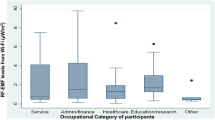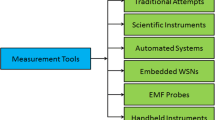Abstract
The article gives an overview of effects occurred with extremely low frequency electromagnetic fields(ELF-EMF) exposure in an informationalized perspective and concludes that reasonable suspicion of any health consequences does not exist based on current evidence of effects at ambient relevant levels, with which, limited exposures regulated by national safety standards and guidelines for habitable areas adjacent to all power lines may not reasonably be presumed to result in relevant adverse impacts and calls for additional multiple effects detecting means of informational techniques. And all special precautions and protective measures should be taken into action to reduce the exposure to electromagnetic fields in aspects of both intensity and frequency as low as reasonably attainable, no matter the effects of electromagnetic fields be as trivial as reasonably negligible. Traditional detecting means show that concrete evidence of electromagnetic fields pathophysiology such as chemical, morphological, and electrical alterations remains uncertain. Nevertheless, in the present information era, mankind is exposed to exceedingly multiple surrounding threats simultaneously, e.g., varied electromagnetic fields and air pollutants, and each combination or the stand-alone risk could potentially have beneficial or harmful effects, thus the definite evidence is far from been founded unless more detailed and large population based trials are to be done and multiple effects detecting means of informational techniques such as image recognition, speech recognition and motion recognition are to be further studied and deployed.
Access this chapter
Tax calculation will be finalised at checkout
Purchases are for personal use only
Similar content being viewed by others
References
World Health Organization. 2007. The international EMF project [DB/OL]. Geneva, Switzerland.
Johansen, C. 2001. Exposure to electromagnetic fields and risk of central nervous sys diseases among employees at Danish electric companies. Ugeskrift for Laeger 164 (1): 50–54.
Noonan, C.W., J.S. Reif, M. Yost, et al. 2002. Occupational exposure to magnetic fields in case-referent studies of neurodegenerative diseases. Scandinavian Journal of Work, Environment & Health 28 (1): 42–48.
Hakansson, N., P. Gustavsson, C. Johansen, et al. 2003. Neurode—Generative diseases in welders and other workers exposed to high levels of magnetic fields. Epidemiology 14 (4): 420–426.
Sher, L. 2000. The effects of natural and man-made electromagnetic fields on mood and behavior: The role of sleep disturbances. Medical Hypotheses 54 (4): 630–633.
Li, C.Y., P.C. Chen, F.C. Sung, et al. 2002. Residential exposure to power frequency magnetic field and sleep disorders among women in an urban community of Northern Taiwan. Sleep 25 (4): 428–432.
Trimmel, M., and E. Schweiger. 1998. Effects of an ELF (50 Hz, 1 mT) electromagnetic field (EMF) on concentration in visual attention, perception and memory including effects of EMF sensitivity. Toxicology Letters 96: 377–382.
Edwin Wijngaarden, E., D.A. Savitz, R.C. Kleckner, et al. 2001. Exposure to electromagnetic fields and suicide among electric utility workers: A nested case-control study. Occupational and Environmental Medicine 57 (4): 258–263.
Thornton, I.M. 2006. Out of time: A possible link between mirror neurons, autism and electromagnetic radiation. Medical Hypotheses 67 (2): 378–382.
Zamanian, Z., S. Gharepoor, and M. Dehghani. 2010. Effects of electromagnetic fields on mental health of the staff employed in gas power plants, Shiraz, 2009. Pakistan Journal of Biological Sciences: PJBS. 13 (19): 956.
Wei, Wei. 2009. Life quality survey of Guangzhou industrial frequency electromagnetic field operators. Guangdong Medicine 30 (7): 1147–1149.
Li, L., D.F. Xiong, J.W. Liu, et al. 2014. No effects of power line frequency extremely low frequency electromagnetic field exposure on selected neurobehavior tests of workers inspecting transformers and distribution line stations versus controls. Australasian Physics Engineering Science Medicine 37 (1): 37–44.
Qidong, Chen, Pan Xiangrong, Chu Qingya, et al. 2008. Epidemiological studies on depression and influencing factors in telecommunication workers. Journal of the Third Military Medical University 30 (12): 1186–1188.
Maffei, Xiong Hongyan, Zhang Yao, et al. 2004. Epidemiological investigation on the effects of high intensity electromagnetic radiation on neurobehavioral function in military working population. Journal of the Third Military Medical University 26 (22): 2048–2050.
Hepuying, Wang Zhengsong, Zhou Hailong, et al. 2007. Effects of urban high-intensity electromagnetic radiation on neurobehavioral function in working populations. Laboratory Medicine and Clinical Practice 4 (6): 568–569.
Deng Zhaohui, Gong Zefen, Yu Zhengping, et al. 2008. Effects of electromagnetic radiation from radar units on the neurobehavioral function of operators. Radiation Health in China 17 (2): 136–137.
Huaizhong, Wang, and Li Guoning. 2002. Effects of paging on neurobehavioral function. Occupational and Health 18 (5): 27–29.
Cooper, A.R., E. Van Wijngaarden, S.G. Fisher, et al. 2009. A population-based cohort study of occupational exposure to magnetic fields and cardiovascular disease mortality. Annals of Epidemiology 19 (1): 42–48.
Ghione, S., C.D. Seppia, L. Mezzasalma, et al. 2005. Effects of 50 Hz electromagnetic fields on electroencephalographic alpha activity, dental pain threshold and cardiovascular parameters in humans. Neuroscience Letters 382 (1): 112–117.
Barth, A., I. Ponocny, E. Ponocny-Seliger, et al. 2010. Effects of extremely low-frequency magnetic field exposure on cognitive functions: Results of a meta-analysis. Bioelectromagnetics 31 (3): 173–179.
Mario, S., L. Bonhomme-Faivre, F. Forestier, et al. 2003. Effects of electromagnetic fields on the immune systems of occupationally exposed humans and mice. Archives of Environmental Health: An International Journal 58 (11): 712–717.
Janac, B., N. Pesi, A. Melenkovic, et al. 2005. The effects of chronic exposure to ELF magnetic field on spontaneous and amphetamine-induced locomotor and stereotype activities in rats. Brain Research Bulletin 67 (6): 498–503.
Liu T., Lei Y., Wilson F.A.W., et al. 2005. Effects of extremely low-frequency electromagnetic fields on morphine-induced conditioned place preferences in rats. Neuroscience Letters 390 (2):72–75.
Prolić, Z., B. Janać, V. Pešić, et al. 2005. The Effect of extremely low-frequency magnetic field on motor activity of rats in the open field. Annals of the New York Academy of Sciences 1048 (1): 381–384.
Tong, Liu, He Lihua, Ye Kangping, Xu Yingchun. 2010. Effects of chronic exposure to the power frequency magnetic field on neural behavior in rats. Journal of Peking University (medical edition) 42 (3): 351–355.
Yokus, B., D.U. Cakir, M.Z. Akdag, et al. 2005. Oxidative DNA damage in rats exposed to extremely low frequency electro-magnetic fields. Free Radical Research 39 (3): 317–323.
Freude, G., P. Ullsperger, S. Eggert, et al. 2011. Effects of microwaves emitted by cellular phones on human slow brain potentials. Bioelectromagnetics 19 (6): 384–387.
Zhao, Q.R., J.M. Lu, J.J. Yao, et al. 2015. Neuritin reverses deficits in murine novel object associative recognition memory caused by exposure to extremely low frequency (50 Hz) electromagnetic fields. Scientific Reports 5: 11768.
Xiao, LIU, ZUO Hongyan, WANG Dewen, et al. 2013. Effects of occupational exposure to electromagnet field on hematologic parameters. High Voltage Engineering 39 (1): 156–162.
Foroozandeh, E., P. Derakhshan-Barjoei, and M. Jadidi. 2012. Toxic effects of 50 Hz electromagnetic field on memory consolidation in male and female mice. Toxicology and Industrial Health 29 (3): 293–299.
Akdag, M.Z., S. Dasdag, E. Ulukaya, et al. 2010. Effects of extremely low-frequency magnetic field on caspase activities and oxidative stress values in rat brain. Biological Trace Element Research 138 (1–3): 238–249.
Piacentini, R., C. Ripoli, D. Mezzogori, et al. 2008. Extremely low-frequency electromagnetic fields promote in vitro neurogenesis via upregulation of Cav1-channel activity. Journal of Cellular Physiology 215 (1): 129–139.
Di Loreto, S., S. Falone, V. Caracciolo, et al. 2009. Fifty hertz extremely low-frequency magnetic field exposure elicits redox and trophic response in rat-cortical neurons. Journal of Cellular Physiology 219 (2): 334–343.
Acknowledgements
This research was supported financially by the China Southern Power Grind (Grant No. GDKJXM20180673 and GDKJXM20185761).
Author information
Authors and Affiliations
Corresponding author
Editor information
Editors and Affiliations
Rights and permissions
Copyright information
© 2020 Springer Nature Singapore Pte Ltd.
About this paper
Cite this paper
Liu, Y., Lin, Z., Li, L., Li, H., Shen, Y. (2020). Effects of Extremely Low Frequency Electromagnetic Fields Exposure in an Informationalized Perspective. In: Huang, C., Chan, YW., Yen, N. (eds) Data Processing Techniques and Applications for Cyber-Physical Systems (DPTA 2019). Advances in Intelligent Systems and Computing, vol 1088. Springer, Singapore. https://doi.org/10.1007/978-981-15-1468-5_140
Download citation
DOI: https://doi.org/10.1007/978-981-15-1468-5_140
Published:
Publisher Name: Springer, Singapore
Print ISBN: 978-981-15-1467-8
Online ISBN: 978-981-15-1468-5
eBook Packages: Intelligent Technologies and RoboticsIntelligent Technologies and Robotics (R0)




